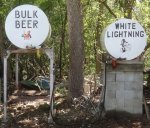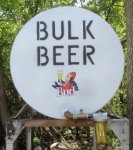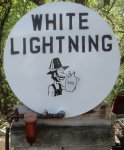Roadrunner, that's an excellent job! If I were to offer (as a rank fuel-tank amateur) any suggestions, I'd suggest you swap the filter and the pump in that line-up to avoid placing suction on the filter, which is better suited for containing pressure and to avoid sucking air and foaming your fuel delivery.
I have used 5-gal plastic jerry-cans for my airplanes (avgas) and other equipment for years and came to hate having to lift the heavy full cans over the hood of the tractor, spilling fuel all over (especially when trying to top-off, because one cannot see very well. I have added little snap-vents to my cans and thrown away the EPA-style nozzles on those cans and used a tractor-funnel, but that is still a heavy/tiring and messy job, especially with diesel fuel.
Here's the solution I've made: I had two friends who gave me some equip't they had no use for... an old 160 gal propane tank, and a 30' delivery-hose/nozzle which was a new replacement intended for a marina system (his BIL sold the marina and had no further use for the new hose/nozzle.) The 30' hose is much longer than needed but has proven useful after-all because I don't have to maneuver/bring the equipment up close to refuel them.
Propane is a "sweet" fuel so I wasn't too worried about the inside of the empty tank but after removing the valves I did look inside with a bright light and found it relatively clean. I figured with a good filter and if I pick the fuel up from a few inches off the bottom there'd be no issue...and so far, that has proven to be true. Absolutely no water or debris has been found in the water/particulate filter so far.
The system is powered by shop-air delivered from my hangar (which you can see in the background) via a regulator set at 10 psi. (Any more would cause the nozzle to "jump" in the hands similar to an unconstrained fire-hose.) Shop air is dry because the shop compressor has a water-separator on it. The air enters the tank thru an air quick-connector, thru the regulator w/gauge, then thru a ball-valve to the tank...pressurizing the tank/fuel.... which is pushed up a dip-tube which has it's bottom end 2" above the tank bottom. The fuel passes up the dip tube, thru another ball-valve, then thru the water/particulate filter, then thru a set of hydraulic quick-disconnects into the hose to the nozzle.
The reason for the quick disconnects on the hose is for when I use the FEL to place the tank on my stock-trailer to haul the tank to the fuel distributor (saving another ten-cents/gal) and the reason for the three ball-valves is 1) to close the tank air inlet, 2) close the tank fuel outlet, and 3) vent tank pressure to atmosphere if necessary (for example, before opening the cap to re-fill the tank.) The ball-valves also are arranged so that in order to remove the tank cap, the valves MUST be placed in a position which vents/removes all pressure from the tank beforehand.
Another ball-valve is fitted to the lowest point of the tank to test/drain for any water. (And a clear tube can be connected between the open drain and the vent valves to allow fuel to enter that tube so tank quantity/contents can be seen, if necessary.) I have no meter on it because I don't feel it necessary for my operation...I keep a log on my fuel delivery into the equipment related to the hour-meters on that equip't. I have the diesel for my Kubota M4700DT tractor, my Kubota RTV-X900, and a Ferguson 5-8B Compactor/Roller (has a John Deere 4239 engine) for maintaining my turf airplane runways among other things. (Hogs sometimes dig up the runways and the roller mashes it back smooth very easily, and compacts the ground which has caused the hogs to lose interest in that area.)
The state laws allow a farmer/rancher to transport fuel in tanks that are not permanently attached to a trailer, so I have farm tags on my trailer which also exempts from Federal HazMat laws in my state, and I only have 7 miles via back-roads to my distributor. I've spent about $125 on building this system and the 140 gals of fuel purchased was at a price that more than made up that amount. The only concern is whether or not I'll use that much fuel in a year, so I've treated the fuel with Diesel-Sta-Bil and Biobor JF biocide (which is what we used in the jets I flew corporately) to prevent issues with cetane or biologicals.
The only issue I've had was a need to re-construct the dip-tube after I discovered pressurized air foaming the fuel delivery. The first dip-tube was threaded in to a reducer screwed thru the underside of that "T" to the reducer at the top of the “T” which also brings pressurized-air into the tank. That NPT style of thread prevented a perfect seal on the underneath side of the reducer, so my second dip-tube was threaded, welded, and then sealed with JB-Weld before installation into the "T", and that has solved the foaming problem.
I plan next to fabricate a 10-ga. metal cover which will hinge/flip-over to replace the correct-color upside-down Home Depot bucket that presently protects the filter/valve system from the elements. I don't have a theft problem where I'm located (in the middle of 1500 acres and 2 miles from the nearest county road...anyone who gets to my place either belongs here or is lost and had to get thru a security gate a half-mile away also)...but a lock could easily be placed on the cover (in case the potential thief happened to bring his air compressor to drive the system.)
Hope this is useful for others. (Edit: Disregard the “wet” look. It had just stopped raining.)













